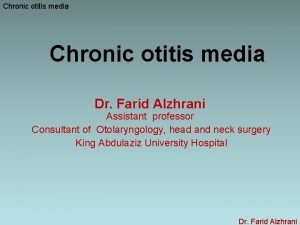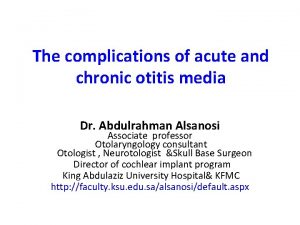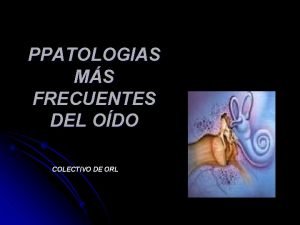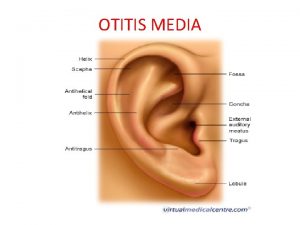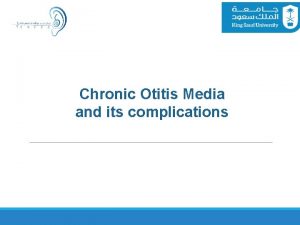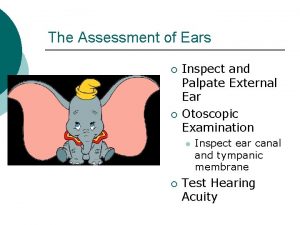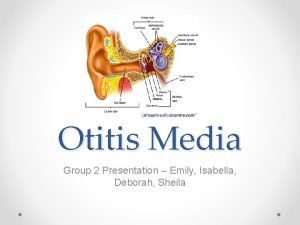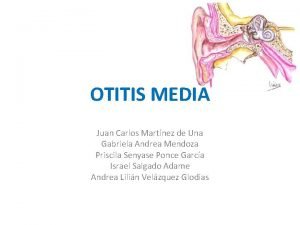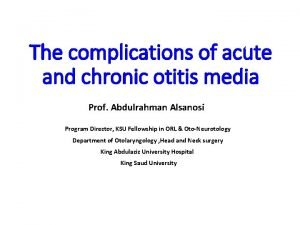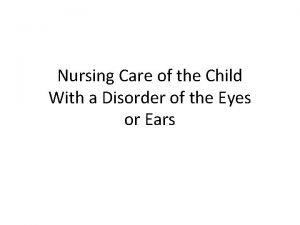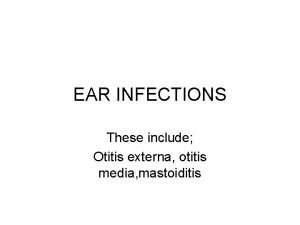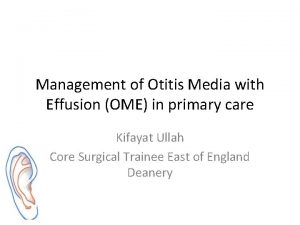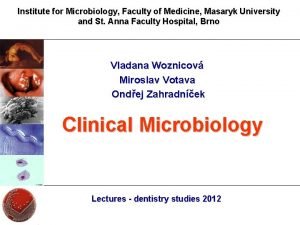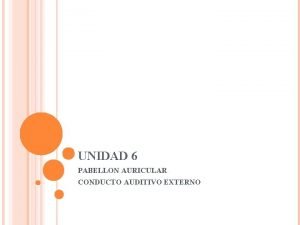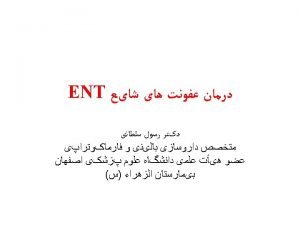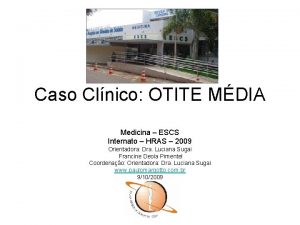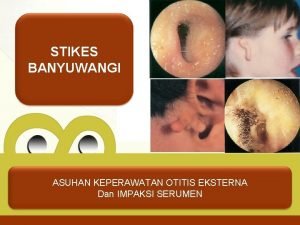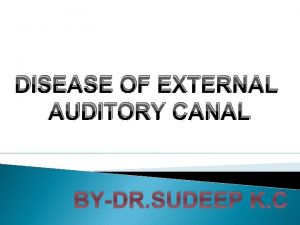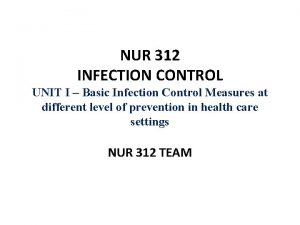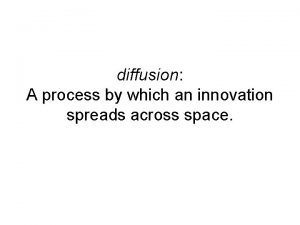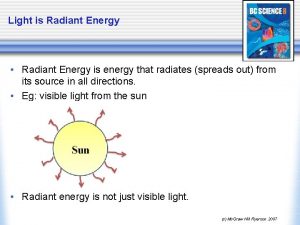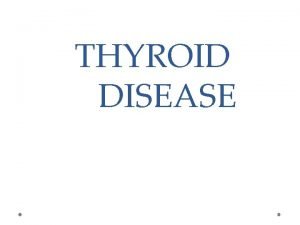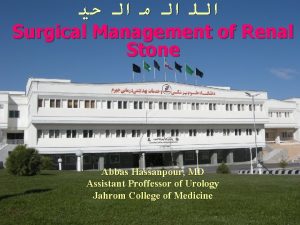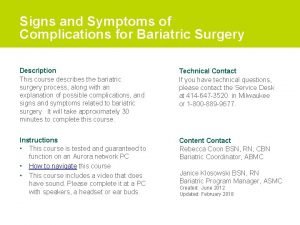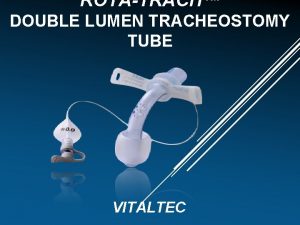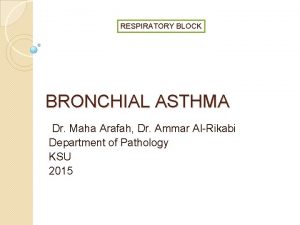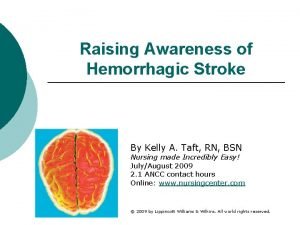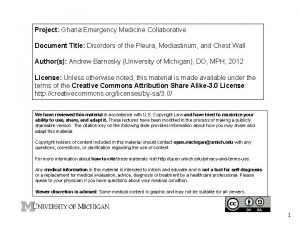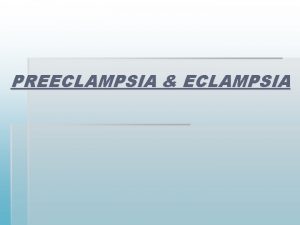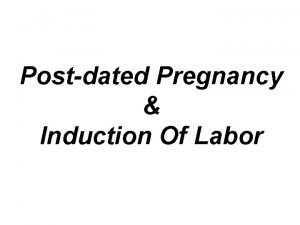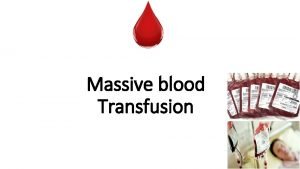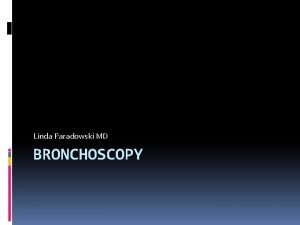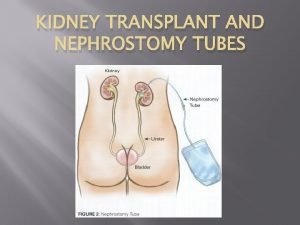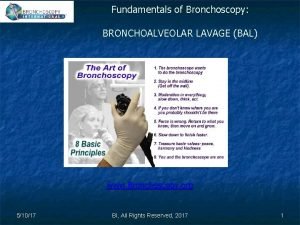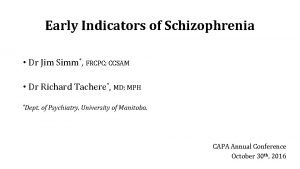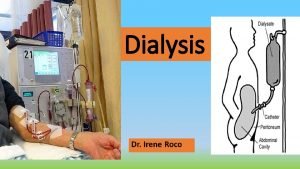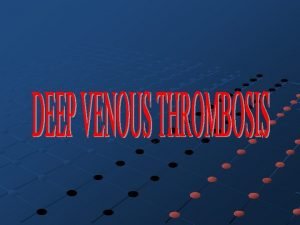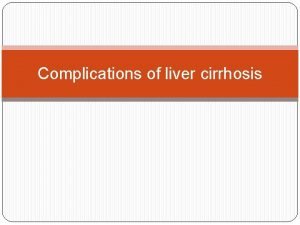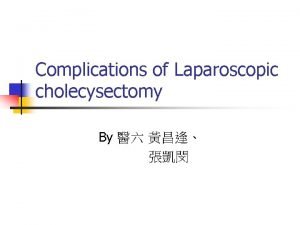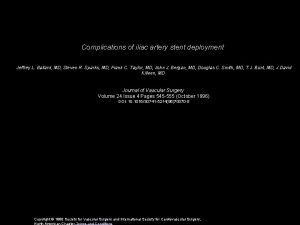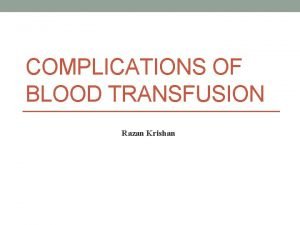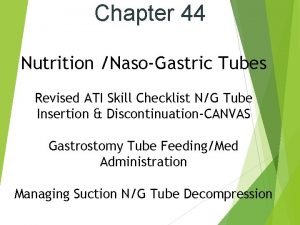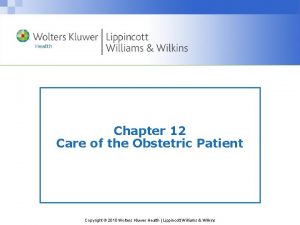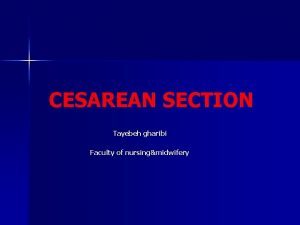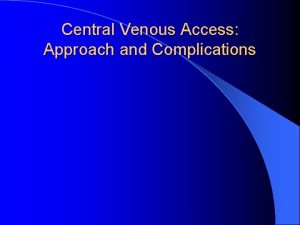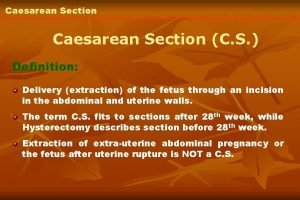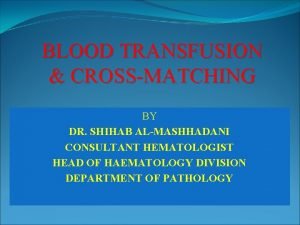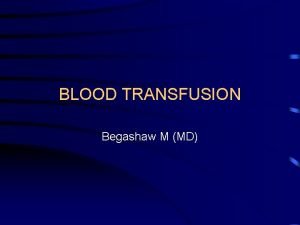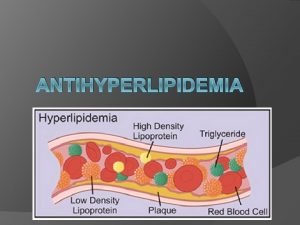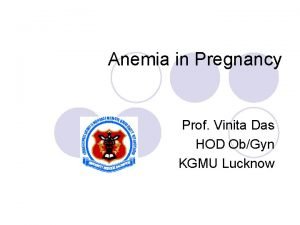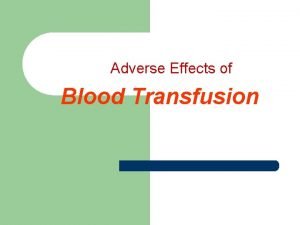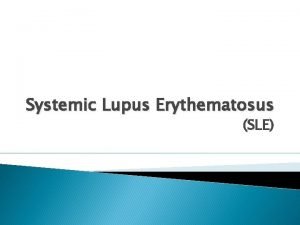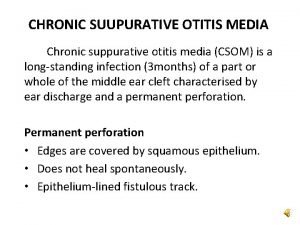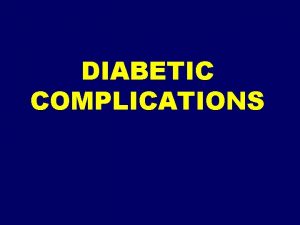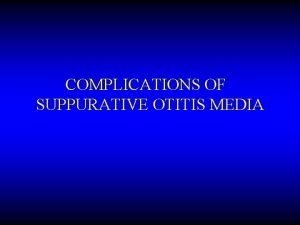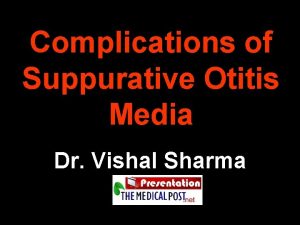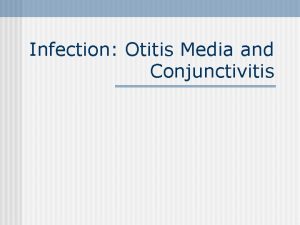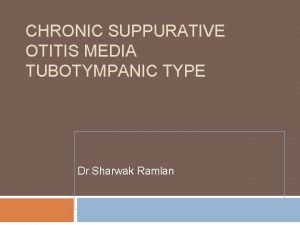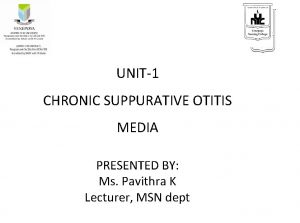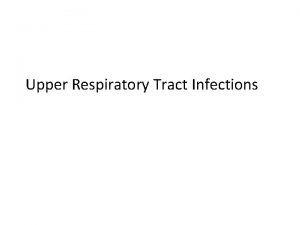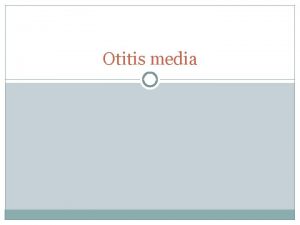Complications of Suppurative Otitis Media Definition Infection spreads


































































































- Slides: 98

Complications of Suppurative Otitis Media

Definition Infection spreads beyond muco-periosteal lining of middle ear cleft to involve bone & neighbouring structures like facial nerve, inner ear, dural venous sinuses, meninges, brain tissue & extra-temporal soft tissue.

Features of Complications • Severe otalgia, painful swelling around ear • Vertigo, nausea, vomiting • Headache + blurred vision + projectile vomiting • Fever + neck rigidity + irritability / drowsiness • Facial asymmetry • Otorrhoea + Retro-orbital pain + diplopia • Ataxia

Classification • Intra-cranial • Extra-cranial, Intra-temporal • Extra-cranial, Extra-temporal • Systemic: septicemia, otogenic tetanus

Classification

Intra-cranial Complications 1. Extra-dural abscess 2. Subdural abscess 3. Meningitis 4. Brain abscess 5. Lateral Sinus thrombophlebitis 6. Otitic hydrocephalus 7. Brain fungus (fungus cerebri)

Intra-temporal Complications • Acute mastoiditis • Coalescent mastoiditis • Masked mastoiditis • Facial nerve palsy • Labyrinthitis • Labyrinthine fistula • Apex Petrositis (Gradenigo syndrome)

Extra-temporal Complications 1. Post-auricular abscess 2. Bezold abscess 3. Citelli abscess 4. Luc abscess 5. Zygomatic abscess 6. Retro-mastoid abscess

Factors Affecting Pathogen Factors Patient Factors High virulence bacteria Young age Antimicrobial resistance Poor immune status Chronic disease (DM, TB) Physician Factors Poor socio-economic status Non-availability Lack of health awareness Injudicious antibiotic use Error in recognizing dangerous symptoms & signs

Routes of entry 1. Bony erosion (cholesteatoma destruction, osteitis) 2. Retrograde Thrombophlebitis 3. Anatomical pathway: oval window, round window, internal auditory canal, suture line, cochlear & vestibular aqueduct 4. Congenital bony defects: facial canal, tegmen plate 5. Acquired bony defects: fracture, neoplasm, stapedectomy 6. Peri-arteriolar space of Virchow-Robin: spread into brain

Erosion of tegmen tympani

Coalescent Mastoiditis or Surgical Mastoiditis

Pathogenesis Aditus Blockage Failure of drainage Stasis of secretions Hyperemic decalcification Resorption of bony septa of air cells Coalescence of small air cells to form cavity Empyema of mastoid cavity

Pathogenesis

Clinical Features & Investigation • Otorrhoea > 2 weeks, otalgia & deafness • Mastoid reservoir sign: pus fills up on mopping • Sagging of postero-superior canal wall due to periosteitis of bony wall b/w antrum & posterior E. A. C. • Ironed out appearance of skin over mastoid due to thickened periosteum • Mastoid tenderness present • Mastoid cavity in X-ray & CT scan

Mastoid reservoir sign

Sagging of posterior wall

Ironed out appearance

Mastoid cavity

Mastoid cavity

Mastoiditis Furunculosis H/o otitis media + - Deafness + - Position of pinna Down + outward + forward Forward Post-aural groove Deepened Obliterated Ear discharge Muco-purulent Serous / purulent Sagging of EAC wall + - TM congestion + - Tenderness Mastoid Tragal Post-aural lymph node - + X-ray Mastoid Coalescence of cells + cavity Normal

Treatment • Urgent hospital admission • Broad spectrum I. V. antibiotics No response to medical treatment in 48 hrs Development of new complication Presence of sub-periosteal abscess – Myringotomy to drain out painful pus – Incision drainage of sub-periosteal abscess – Cortical Mastoidectomy

Sub-periosteal abscess & fistula

Pathology Production of pus under tension hyperaemic decalcification (halisteresis) + osteoclastic resorption of bone sub-periosteal abscess penetration of periosteum + skin fistula formation

Sub-periosteal abscess formation

Sub-periosteal fistula: dry

Sub-periosteal fistula: wet

Types of sub-periosteal abscess • Post-auricular • Bezold • Citelli • Zygomatic • Luc • Retro-mastoid • Parapharyngeal & Retropharyngeal

Types of sub-periosteal abscess

Post-auricular abscess Commonest. Present behind the ear. Pinna pushed forward & downward.

Bezold & Citelli abscesses Bezold: neck swelling over sternocleidomastoid muscle Citelli: neck swelling over posterior belly of digastric muscle

Bezold’s abscess

D/D of Bezold’s abscess 1. Suppurative lymphadenopathy of upper deep cervical lymph node 2. Para-pharyngeal abscess 3. Parotid tail abscess 4. Infected branchial cyst 5. Internal jugular vein thrombosis

Luc: swelling in external auditory canal Zygomatic: swelling antero-superior to pinna + upper eyelid oedema Retro-mastoid: swelling over occipital bone (? Citelli’s abscess) Parapharyngeal & Retropharyngeal: due to spread of pus along Eustachian tube

Retromastoid abscess

Incision drainage of abscess

Gradenigo syndrome Persistent otorrhoea: despite adequate cortical mastoidectomy Retro-orbital pain: Trigeminal nv involvement Diplopia: convergent squint due to lateral rectus palsy by injury to abducent nv in Dorello’s canal under Gruber’s petro-sphenoid ligament, at petrous apex

Persistent otorrhoea + Retro-orbital pain + Convergent squint

Right Convergent squint Right gaze Central gaze Left gaze

Etiology: Coalescent mastoiditis involving petrous apex along postero-superior & anteroinferior tracts in relation to bony labyrinth Diagnosis: 1. C. T. scan temporal bone for bony details. 2. M. R. I. to differ b/w bone marrow & pus Treatment: Modified radical mastoidectomy & clearance of petrous apex cells

C. T. scan & M. R. I.

Hearing preserving approaches to petrous apex • Eagleton’s middle cranial fossa approach • Frenckner’s subarcuate approach • Thornwaldt’s retro-labyrinthine approach • Dearmin & Farrior’s infra-labyrinthine approach • Farrior’s hypotympanic sub-cochlear approach • Lempert Ramadier’s peri-tubal approach • Kopetsky Almoor’s peri-tubal approach


Hearing sacrificing approaches to petrous apex • Trans-cochlear approach • Trans-labyrinthine approach

Spread of pus

Labyrinthitis

Introduction Inflammation of endosteal layer of bony labyrinth Route of infection: Round window membrane Pre-formed opening (Stapedectomy) Retrograde spread of meningitis via IAC / aqueducts Clinical forms: 1. Circumscribed (labyrinthine fistula) 2. Diffuse serous 3. Diffuse suppurative

• Circumscribed: Fistula commonly involves lateral SCC. Presents with transient vertigo & positive fistula test I/L nystagmus with +ve pressure; C/L nystagmus with -ve pressure • Serous: Reversible, non-purulent, mild vertigo, I/L nystagmus, mild sensori-neural hearing loss • Purulent: Irreversible, purulent, severe vertigo, C/L nystagmus, severe / profound hearing loss

Treatment: Bed rest (affected ear up). Avoid head movement. Labyrinthine sedative: Prochlorperazine, Cinnarizine Broad spectrum I. V. antibiotics Modified Radical Mastoidectomy: removes infection Open labyrinthine fistula: cover with temporalis fascia Fistula covered with cholesteatoma matrix < 2 mm: remove matrix & cover with temporalis fascia > 2 mm / multiple / over promontory: leave it Rehabilitation by Cawthorne-Cooksey Exercises

Lateral SSC Fistula


Facial nerve paralysis • Within 1 st wk: due to nerve sheath edema • After 2 wks: due to bone erosion • Lower motor neuron palsy • Common in tubercular otitis media Treatment: • Modified Radical Mastoidectomy • Facial nerve decompression seldom required

Meningitis

• High grade persistent fever with rigors • Severe headache & neck stiffness • Irritability drowsiness confusion coma • Neck rigidity positive • Kernig sign positive; Brudzinski sign positive • Papilloedema • Lumbar Puncture: cell count, protein, sugar • I. V. Ceftriaxone + Metronidazole + Gentamicin • Radical Mastoidectomy once patient is stable

Test for neck rigidity

Kernig’s sign

Brudzinski’s neck sign

Otogenic brain abscess

Introduction 50 -75 % adult brain abscess & 25% in child = otogenic Temporal abscess : Cerebellar abscess = 2: 1 Route of infection: 1. Direct spread: via Tegmen plate: Temporal abscess via Trautmann’s triangle: Cerebellar abscess 2. Retrograde thrombophlebitis

Trautmann’s triangle Superiorly: superior petrosal sinus Posteriorly: sigmoid sinus Anteriorly: solid angle (semi-circular canals) Pathway to posterior cranial fossa from mastoid cavity

Stages of brain abscess 1. Invasion or Encephalitis (1 -10 days) 2. Localization or Latent Abscess (10 -14 days) 3. Expansion or Manifest Abscess (> 14 days): leads to raised intracranial tension & focal signs 4. Termination or Abscess rupture: leads to fatal meningitis

Stages of brain abscess

Clinical Features of ed I. C. T. Seen more in cerebellar abscess • Severe persistent headache, worse in morning • Projectile vomiting • Blurring of vision & Papilloedema • Lethargy drowsiness confusion coma • Bradycardia • Subnormal temperature

Focal Clinical Features Temporal Lobe Cerebellum Nominal aphasia I/L nystagmus Quadrantic homonymous I/L weakness I/L hypotonia hemianopia (C/L) Epileptic seizures I/L ataxia Pupillary dilatation Intention tremor Hallucination (smell & taste) Past-pointing C/L hemiplegia Dysdiadochokinesia

Bacteriology • Anaerobic streptococci • Streptococcus pneumoniae • Staphylococci • Proteus • E. coli • Pseudomonas • Bacteroidis fragilis

Investigations CT scan of brain & temporal bone with contrast Site, size & staging of abscess Observe progression of brain abscess Associated intra-cranial complications MRI brain D/D: pus, abscess capsule, edema & normal brain Spread to ventricles & subarachnoid space Avoid lumbar puncture to prevent coning

Temporal abscess in CT scan

Cerebellar abscess

Medical Treatment • High dose broad spectrum I. V. antibiotics: Ceftriaxone + Metronidazole + Gentamicin • I. V. Dexamethasone 4 mg Q 6 H: es oedema • I. V. 20% Mannitol (0. 5 gm/kg): es I. C. T. • Anti-epileptics: Phenytoin sodium • Antibiotic ear drops & aural toilet

Surgical Treatment • Repeated burr hole aspirations • Excision of brain abscess with capsule: best Tx • Open incision & evacuation of pus • Radical mastoidectomy after pt becomes stable

Lateral sinus thrombophlebitis

Pathogenesis Lateral sinus = Sigmoid sinus + Transverse sinus Erosion of sigmoid sinus plate peri-sinus abscess inflammation of outer wall endophlebitis mural thrombus occlusion of sinus lumen intra-sinus abscess propagating infected thrombus


Pathogenesis

Spread of thrombus Proximal: 1. To superior sagittal sinus via torcula Hirophili hydrocephalus 2. To cavernous sinus proptosis 3. To mastoid emissary vein Griesinger’s sign Distal: To internal jugular vein & subclavian vein pulmonary thrombo-embolism & septicaemia

Clinical Features • Remittent high fever with rigors (picket fence) • Pitting edema over retro-mastoid area & occipital bone due to mastoid emissary vein thrombosis (Griesinger’s sign) • Tenderness along Internal Jugular Vein • Headache • Anaemia

Fever charts in C. S. O. M. Brain abscess Meningitis Lateral Sinus Thrombophlebitis

Picket fence fever • High fever, swinging type • Chills precedes fever • Temperature subsides with sweating • Each fever spike due to release of fresh septic embolus

Special Tests • Queckenstedt or Tobey-Ayer test: compression of I. J. V. rapid rise of C. S. F. pressure (50 – 100 mm water rapid fall on release of compression. In L. S. T. no rise / rise by only 10 – 20 mm water. • Lillie – Crowe - Beck test: pressure on I. J. V. on normal side engorgement of retinal veins + papilloedema seen in fundoscopy due to L. S. T. on opposite side.

Tobey Ayer Test

Retinal vein dilation & optic disc edema

Investigations Lumbar puncture: to rule out meningitis CT brain with contrast: MRI brain with contrast: Delta sign or Empty triangle sign MR angiography Blood culture Culture & sensitivity of ear discharge Peripheral blood smear: to rule out malaria

Delta sign

Treatment 1. Radical mastoidectomy: Removal of disease + needle aspiration to confirm diagnosis. Sinus wall incised. Infected clots removed & abscess drained. 2. I. V. Ceftriaxone + Metronidazole + Gentamicin 3. Anticoagulants: in cavernous sinus thrombosis 4. Internal jugular vein ligation: for embolism not responding to antibiotics & surgery 5. Blood transfusion: for anaemia

Extra-dural abscess

Extra-dural abscess

Commonest otogenic intra-cranial complication Collection of pus b/w skull bone & dura of middle or posterior cranial fossa Majority asymptomatic. Suspected in case of: Profuse, intermittent, pulsatile, purulent, otorrhoea Low grade fever I/L Persistent headache Recurring meningococcal meningitis CT scan brain shows extra-dural abscess Tx: I. V. Ceftriaxone + Metronidazole + Gentamicin Modified Radical mastoidectomy Drill tegmen or sinus plate pus drained

Extra-dural abscess

Subdural abscess

Subdural abscess

Collection of pus b/w dura & arachnoid by erosion of bone & dura mater or by retrograde thrombophlebitis Due to rapid spread of pus, symptoms of raised intracranial tension & meningeal irritation develop quickly CT scan brain shows subdural abscess Tx: I. V. Ceftriaxone + Metronidazole + Gentamicin Burr hole evacuation of pus Radical mastoidectomy after pt becomes stable

Subdural abscess

Otitic Hydrocephalus

Synonym: Benign intra-cranial hypertension Symond’s syndrome Etiology: 1. Associated L. S. T. obstruction of cerebral venous return. 2. Superior sagittal sinus thrombosis ed C. S. F. absorption Clinical Features: 1. Severe headache, vomiting 2. Blurred vision, papilloedema, optic atrophy 3. Abducens palsy & diplopia due to raised intra-cranial tension (False localizing sign)

Investigations: 1. Lumbar puncture: ed CSF pressure (> 300 mm H 2 O). Biochemistry & bacteriology normal 2. CT scan brain: normal ventricles Treatment: 1. Tx of L. S. T. : I. V. antibiotics & MRM 2. se CSF pressure (prevents optic atrophy) by: I. V. Dexamethasone 4 mg Q 6 H I. V. 20% Mannitol 0. 5 gm/kg Repeated lumbar puncture / lumbar drain Ventriculo-peritoneal shunt

Brain Fungus • Prolapse of brain into middle ear cavity / mastoid cavity due to erosion of dural plate. • Common in pre-antibiotic era. Rarely seen now in resistant infections. • Diagnosis: C. T. scan temporal bone. • Treatment: Removal of necrotic tissue, replacement of healthy prolapsed brain into cranial cavity & repair of bone defect.

Fungus Cerebri

Thank You
 Acute suppurative otitis media
Acute suppurative otitis media Otitis media complications
Otitis media complications Catarrhal appendicitis
Catarrhal appendicitis Morphological pattern of inflammation
Morphological pattern of inflammation Acute suppurative appendicitis
Acute suppurative appendicitis 09112007 color
09112007 color Clasificación de la otitis media
Clasificación de la otitis media Pruebas acumetricas
Pruebas acumetricas Adhesive otitis media
Adhesive otitis media Kode icd tinitus
Kode icd tinitus Nonsuppurative otitis media
Nonsuppurative otitis media Ear palpation
Ear palpation Tympanosclerosis
Tympanosclerosis Otitis media
Otitis media Wikimedia
Wikimedia Fpnotebook otitis media
Fpnotebook otitis media Otitis media with effusion otoscopy
Otitis media with effusion otoscopy Ligamentos timpanomaleolares
Ligamentos timpanomaleolares Otitis media ppt
Otitis media ppt Nursing diagnosis for otitis media slideshare
Nursing diagnosis for otitis media slideshare Classification of otitis media
Classification of otitis media Myringotomy nursing interventions
Myringotomy nursing interventions Streptococcus pneumoniae otitis media
Streptococcus pneumoniae otitis media Otitis media ppt
Otitis media ppt Oma vs ome
Oma vs ome Tragus asesorius
Tragus asesorius Patho
Patho Meatoestenosis
Meatoestenosis Aumentativo de ropero
Aumentativo de ropero Laryngitis
Laryngitis Scalp salinizado
Scalp salinizado Askep otitis eksterna
Askep otitis eksterna Otitis
Otitis Differential diagnosis of otitis externa
Differential diagnosis of otitis externa Tuberculo darwin
Tuberculo darwin Clotimoxazole
Clotimoxazole Infection control definition
Infection control definition Difference between spread and fillings
Difference between spread and fillings The enlightenment spreads chapter 6 section 3
The enlightenment spreads chapter 6 section 3 Baroque definition enlightenment
Baroque definition enlightenment Cheese spread mre
Cheese spread mre Industrialization spreads chapter 25 section 3
Industrialization spreads chapter 25 section 3 Industrialization spreads
Industrialization spreads Chapter 9 section 3 industrialization spreads answer key
Chapter 9 section 3 industrialization spreads answer key Innovation spreads by the process of
Innovation spreads by the process of What is radiant energy examples
What is radiant energy examples Chapter 6 section 3 the enlightenment spreads answer key
Chapter 6 section 3 the enlightenment spreads answer key Understanding credit spreads
Understanding credit spreads What is literal imagery
What is literal imagery Sasprin
Sasprin Speed stacks spreads nationally in 1998.
Speed stacks spreads nationally in 1998. How cancer spreads
How cancer spreads Fats spreads and oils
Fats spreads and oils The enlightenment spreads
The enlightenment spreads The enlightenment spreads
The enlightenment spreads 300 bc china
300 bc china Hypothyroidism complications
Hypothyroidism complications Eswl complications
Eswl complications Complications c section
Complications c section Sleeve gastrectomy complications
Sleeve gastrectomy complications Complications of shigellosis
Complications of shigellosis Site:slidetodoc.com
Site:slidetodoc.com Bronchial asthma
Bronchial asthma Cva complications
Cva complications Primary vs secondary spontaneous pneumothorax
Primary vs secondary spontaneous pneumothorax Complications of eclampsia
Complications of eclampsia Modified bishop score
Modified bishop score Post dated pregnancy complications
Post dated pregnancy complications Types of episiotomy
Types of episiotomy Blood transfusion complications
Blood transfusion complications Bronchoscopy complications
Bronchoscopy complications Neph tubes
Neph tubes Varicella zoster complications
Varicella zoster complications Bronchoscopy complications
Bronchoscopy complications Complications of schizophrenia
Complications of schizophrenia Septoplasty complications
Septoplasty complications Peritoneal dialysis complications
Peritoneal dialysis complications Phlegmasia alba dolens definition
Phlegmasia alba dolens definition Splenomegaly liver cirrhosis
Splenomegaly liver cirrhosis Abdominal insufflation complications
Abdominal insufflation complications Iliac stent complications
Iliac stent complications Heart failure complications
Heart failure complications Complications of blood transfusion
Complications of blood transfusion Ng tube insertion steps ati
Ng tube insertion steps ati Complications of gestational diabetes
Complications of gestational diabetes C section layers
C section layers Central venous line complications
Central venous line complications Contraindications of cesarean section ppt
Contraindications of cesarean section ppt Complications after cesarean section
Complications after cesarean section Blood transfusion complications
Blood transfusion complications What are the complications of blood transfusion
What are the complications of blood transfusion Blood transfusion requirements
Blood transfusion requirements Hyperlipidemia complications
Hyperlipidemia complications Cases of iron deficiency anemia
Cases of iron deficiency anemia Massive transfusion complication
Massive transfusion complication Berotec nebs
Berotec nebs Short stories with protagonist and antagonist
Short stories with protagonist and antagonist Sle mnemonic soap brain md
Sle mnemonic soap brain md Septic arthritis complications
Septic arthritis complications
